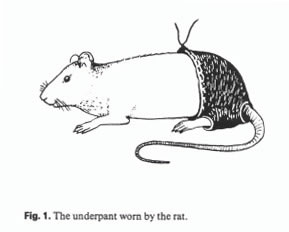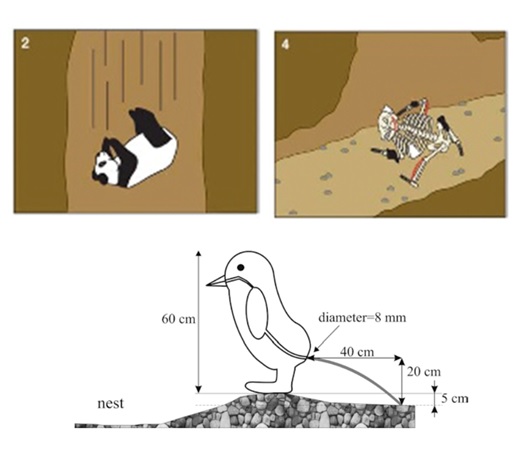You may not know it yet, but higher education has a hidden silly side.
There are of course the infamous Ig Nobel prizes, which rewards scientists for research that makes people laugh, and then makes them think. Winners have included Andre Geim (also a real Nobel winner) for levitating a frog, and the authors of a paper analysing the neuroscience behind why people think they see Jesus in their toast.
But the vein of oddness runs much deeper than just silly science. There are cats writing about high-temperature physics, jokes hidden in papers alongside acknowledgements to porn stars and cargo cult gods, and academics with sidelines in stand-up comedy.
I started the Academia Obscura blog a year ago to explore the bizarre world behind the intellectual veneer and the elbow patches. Now I am working with Unbound to crowdfund the Academia Obscura book. In this piece I share my personal favourites.
Funny Figures
Many figures in scientific papers are a little lacking in inspiration. Occasionally they are even lacking in data. However, if you look hard enough, you will find some incredible illustrations and images, from unicorns to Napoleon.
My favourite comes from a study entitled “Effect of different types of textiles on sexual activity”. The study involved dressing rats in trousers made of varying blends of cotton and polyester for an extended period and then measuring their level of sexual activity. Supposedly the static electricity generated by the polyester pants caused a decrease in sexual activity, but the real result of this study is one of the finest figures ever to grace a scientific journal.

A similar study has been conducted with dogs, though unfortunately no photos are provided. Other gems include a graphic depiction of how a panda might have fallen to its death and a diagram from a paper calculating how forcefully Chinstrap Penguins defecate.

Dubious Journals
The vast majority of academics have at some point received an email requesting their contribution to a journal of questionable legitimacy. While a number of journals walk a fine line between legitimate and fake, others are brazen in their complete disregard for any scientific standards.
The American Based Research Journal (ABRJ), for example, calls itself an “Open-Access–Monthly–Online–Double Blind Peer Reviewed Journal”. This American-based journal has its office in a nondescript suburban lane in Manchester, covers a truly baffling range of topics (business management to fashion trends), and is edited by one “Dr Merry Jeans”.
Dr Jeans is assisted in her lofty task by other well-known scholars, such as “Dr Belly Joseph” and “Dr Jazzy Rolph”. After a bit of digging, I found that the “journal” is operated from the bedroom of a Pakistani student, previously censured by his university for distributing exam answers.
If the ABRJ doesn’t take your fancy, you might like to try the Integrated Journal of British. As journal watchdog Jeffrey Beall puts it: “If the journal’s name strikes you as strange, that’s because it is strange.” The journal’s impact factor, itself provided by a sham rating company, is touted as a very precise 3.3275, while their logo is apparently lifted from the website of a Wisconsin home improvement company. I only hope that the $150 publication fee for these journals can be paid in Monopoly money.
Cats and Dogs
When I started the #AcademicsWithCats hashtag it was intended just as a bit of fun. Little did I know that academia, like the internet at large, is fuelled by cats. Hundreds of pictures flooded in, we ran an online award for the best cat pictures, and the hashtag is still being used daily.
#AcademicsWithCats Winner, Scholarly Cats: @EngProfD Congratulations! http://t.co/iXh6zz5Xh5 pic.twitter.com/4xgqDrpAhe
— Academia Obscura (@AcademiaObscura) January 21, 2015
I should not have been surprised – academia has a long connection with cats, dogs, and other furry friends. Andre Geim, mentioned earlier, listed his pet hamster as a co-author on one of his papers, while Polly Matzinger co-authored with her dog.
The cat of American physicist Jack Hetherington, FDC Willard, has not only co-authored papers, but is also the sole author of one paper, in French no less. In recognition of this achievement, American Physical Society Journals last year announced that all feline-authored publications would be made open access (“not since Schrödinger has there been an opportunity like this for cats in physics”, they said).
You might think it risky to be including animal co-authors, but contrary to popular belief, most academics do have a sense of humour. Commenting on Matzinger’s canine co-author, her tenure committee decided that “it wasn’t really fraud. It was a real dog, a frequent lab visitor, and they said it had done no less research than some other coauthors had”!
Glen Wright blogs at Academia Obscura and tweets at @AcademiaObscura. His book is crowdfunding now.
Register to continue
Why register?
- Registration is free and only takes a moment
- Once registered, you can read 3 articles a month
- Sign up for our newsletter
Subscribe
Or subscribe for unlimited access to:
- Unlimited access to news, views, insights & reviews
- Digital editions
- Digital access to THE’s university and college rankings analysis
Already registered or a current subscriber? Login





